If you’re looking for a houseplant that is easy to grow and can withstand various growing requirements, look no further than the Philodendron plant. This has long been a beloved houseplant, grown for its large, attractive foliage that adds texture and character to a room.
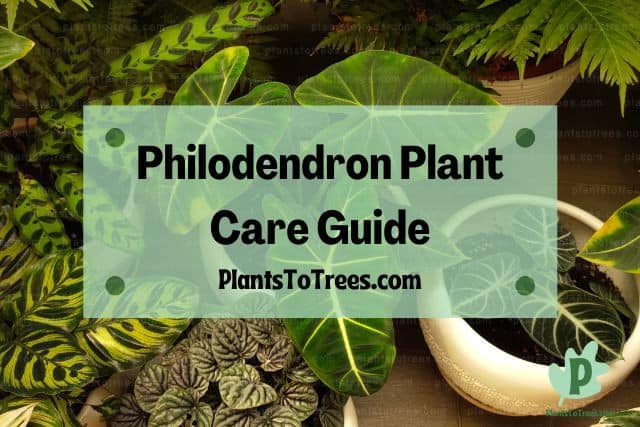
Having a Philodendron plant care guide will help ensure you give this tropical plant the best chance of survival. You will learn that Philodendrons are not frost tolerant and cannot stand cold temperatures, as well as the lighting, watering, and soil requirements for this popular houseplant.
While the Philodendron plant does prefer bright, indirect sunlight, it can also tolerate lower levels of light and even some shade. It’s this low maintenance that makes the Philodendron plant a must have for indoor gardeners just starting their adventure into the world of plants.
Because they are native to tropical regions, the Philodendron plant thrives in areas where the temperature is mild and warm, and the humidity is a bit high. In most cases, however, these plants can grow well at the average temp and humidity level found in most homes.
As for the watering requirements, Philodendron plants don’t require an abundance of water and will probably need watering about the same time as your other houseplants. They are not overdramatic plants, and won’t immediately wilt if they are not hydrated at the optimal time. You will want to take care not to overwater these plants as it can cause root rot.
Philodendron plants are also not susceptible to many diseases, but they are also not immune to them. Keeping the plant healthy will ensure it can handle most issues that may come up. Avoid wetting the leaves when watering, however, as this can greatly increase the chance of various fungal or bacterial diseases occurring.
Another thing to consider is the toxicity of the Philodendron plant. Philodendrons are considered mildly to moderately toxic to both humans and pets. This may not be a huge concern, especially if you’re in a home with no children or pets. If, however, you do share your home with little ones, dogs, or cats, keeping them away from the Philodendron is vital to their safety.
Other Names Of Philodendron Plant
Most plants go by various names, which can make it difficult to determine if the plant you are talking about is the same as what someone else is referring to.
Philodendron plants are most known by the name Philodendron, but it is also sometimes referred to as fiddle leaf Philodendron or heartleaf Philodendron. Some people mistakenly call Philodendrons the Swiss cheese plant even though these two houseplants belong to different families.
Frost Tolerance And USDA Hardiness Zone Of Philodendron Plant
The USDA hardiness zone provides important information that gardeners need to know. It informs you what areas a certain plant can grow outside, as well as whether or not a plant can tolerate cold temps and frost.
Philodendron are not a frost-tolerance plant, and they need warm, mild weather. They grow outdoors in USDA plant hardiness zones 9 through 11. Gardeners who live in areas that experience bouts of cold and freezing temperatures will have to grow this tropical plant indoors.
If you would rather find a plant that can grow outdoors in your hardiness zone, your best bet is to visit a local garden center. Most garden centers only offer plants that can grow in that specific zone. Although they may have houseplants available which cannot grow outdoors in your area, they are typically listed as houseplants.
How Many Hours Of Sunlight Does Philodendron Plant Need?
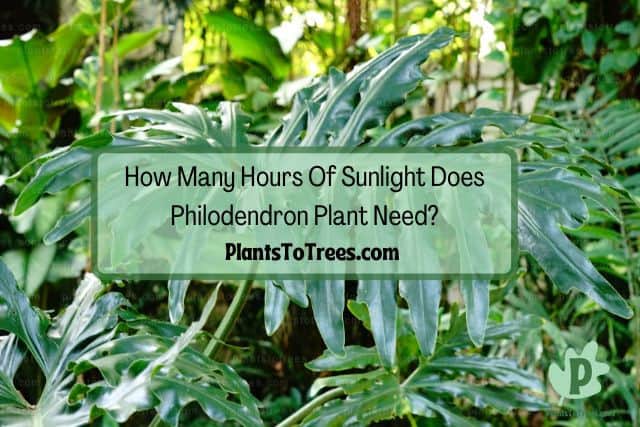
Philodendron plants are not too picky when it comes to the amount of sunlight they need. In fact, these plants can tolerate some shade and low light conditions. With that said, however, they grow best when they can have at least a few hours of sun every day.
Philodendron plants only need 2 to 3 hours of sunlight every day, but they will grow better if given more light. Aim for 6 to 8 hours of indirect light if you want your plant to grow faster, stronger, and produce an abundance of leaves.
Philodendron plants can also be grown under artificial lighting as well, which is great for small apartments and door rooms where windows are scarce. Just make sure to keep the lights at a good distance away from the plant to prevent burning its leaves.
Philodendron Plant Needs Direct Or Indirect Sunlight?
Direct or indirect sunlight, that is the question that gardeners need to ask themselves when they are trying to figure out the best location to place their Philodendron plant.
Philodendron plants need indirect sunlight since they are more susceptible to burning if placed in direct light. Medium to bright light that is filtered is ideal for these houseplants. Setting the plant a few feet away from a window that faces south typically works well for this plant.
Is Philodendron Plant An Indoor Plant, Outdoor Plant Or Both?
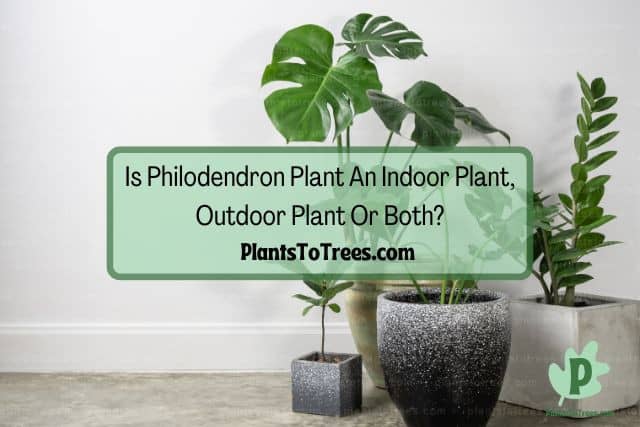
While most people grow the Philodendron plant indoors, it can also be grown outside if you live in certain hardiness zones.
Philodendron plants are mainly grown indoors as a houseplant, but can thrive outside if you live in USDA plant hardiness zones 9 to 11. Philodendrons that are grown indoors can be taken outside if the weather permits.
Even if you grow this plant indoors, you should keep it away from areas that experience temperature fluctuations. This includes near a heating and cooling vent, drafty windows and doors and exterior doors that are regularly used.
During periods of warm weather, such as during the summer, you can take indoor Philodendrons outside for a bit. If you do this, you still need to make sure the plan has the required growing conditions, such as keeping it out of direct sunlight. Setting the Philodendron plant on your porch where it is protected from the sun’s rays, as well as the weather, is the ideal location for indoor Philodendrons. Just don’t forget to bring the plant back inside if the weather starts to fall below 65 degrees.
What Are The Indoor Lighting Requirements of the Philodendron Plant?
While the Philodendron plant can tolerate some shade, it is best to try to provide them with their optimal lighting requirements. This will help ensure the plant is healthy and happy for a long time.
In their natural environment, the Philodendron plant would receive dappled light. Indoor gardeners should try to mimic these lighting conditions as much as possible. Place them near a window where they can receive indirect, bright light.
Not giving the plant enough light will cause them to become leggy with the leaves developing further apart. On the opposite side of the scale, placing the Philodendron plant in harsh or direct sunlight will burn the leaves and dry the plant out.
What Are The Outdoor Lighting Requirements of the Philodendron Plant?
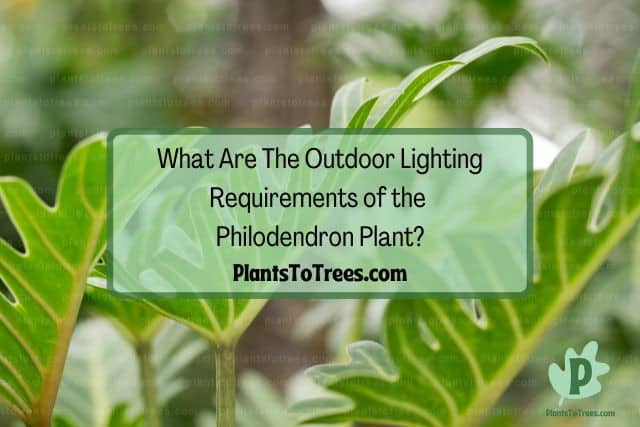
Whether grown indoors or out, most plants have the same lighting requirements, and the Philodendron plant is no different.
When planting the Philodendron plant outdoors, select a sight where the plant can get indirect or dappled sunlight. Philodendrons are forest plants that are protected from the harsh sun by the tropical canopy above. Keep this in mind when deciding where to plant the Philodendron.
What Soil Requirements Does a Philodendron Plant Need?
Not all soil is created equal, and some allow for water to drain through quickly while others hold onto moisture for much longer. Choosing the right soil for your Philodendron will help ensure it stays healthy for years to come.
Philodendron plants like soil that stays moist without being soggy. Potting mix designed for indoor plants works well for the Philodendron. For the best results, consider planting the Philodendron in glazed clay or plastic containers.
Glazed clay and plastic containers don’t dry out the soil as quickly as ceramic or unglazed clay containers. No matter what material the container is made out of, it is vital that it has drainage holes at the bottom and not along the sides.
When a pot has drainage holes along the sides, the excess water has to reach that certain height before it drains out of the pot. This means the bottom of the pot stays soggy, which can result in root rot. Having drainage holes at the bottom allows for all the excess water to drain out.
How Much Water Does a Philodendron Plant Need?
The amount of water a plant needs is a vital part of gardening. Not providing the right amount can cause the plant to wither and die, and even result in fungal diseases.
A good general rule of thumb is to water the Philodendron plant once a week. However, various factors can affect this timeline. The age and size of the plant, temperature, humidity, and type of soil can all lead to more or less watering.
No matter what plant you are growing or how much water it needs, you should always perform a soil moisture test before watering. To do this, simply insert your finger about one to two inches into the plant’s soil. If it feels dry, it’s time to water. If, however, it still feels moist, wait a couple of days and then test the soil again.
Is My Philodendron Plant Overwatered, What Are The Symptoms?
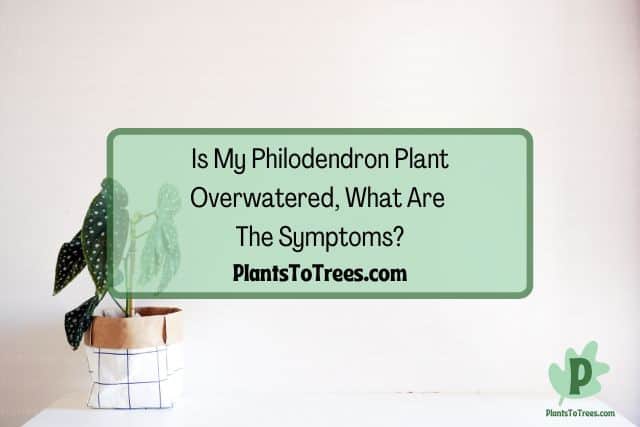
Overwatering Philodendron plants is a preventable problem that occurs far too often. Unfortunately, a plant that has been overwatered can quickly decline. To make matters even worse, it is hard to save a plant that has been overwatered.
When a Philodendron plant is overwatered, its leaves will begin to wilt and turn brown with a soft texture. You may also notice a white or crystal-like layer on the surface of the soil. This is salts building up on the top, which is a common sign of overwatering.
It is typically too late to save a plant once you start to see signs of overwatering. In most cases, the overwatered Philodendron plant will need to be discarded and you will have to start new with a healthy plant.
Before you toss the plant, however, you can try to save it by repotting the Philodendron in fresh soil. This will require you to remove the plant from its old pot, get rid of all the soil, including the soil around the roots, and remove any dead, brown, or diseased roots from the plant. There is no guarantee that this will save the plant and you may still have to get rid of the Philodendron if the root rot has already taken hold.
Is My Philodendron Plant Underwatered, What Are The Symptoms?
Underwatering is not nearly as serious as overwatering, but it can cause a few unwanted symptoms to your Philodendron plant.
Discolored and wilted leaves are the two most common signs that your Philodendron plant is underwatered. The plant will also experience slowed or stunted growth. Plants that have been severely underwatered will need a good soak to revive them.
Don’t be too upset with yourself if you accidentally underwater the Philodendron. In most cases, the plant will be fine if you correct the underwatering. Keep in mind, however, that any leaves that are discolored due to the underwatering will not go back to their usual green color.
How Much Fertilizer Does a Philodendron Plant Need?
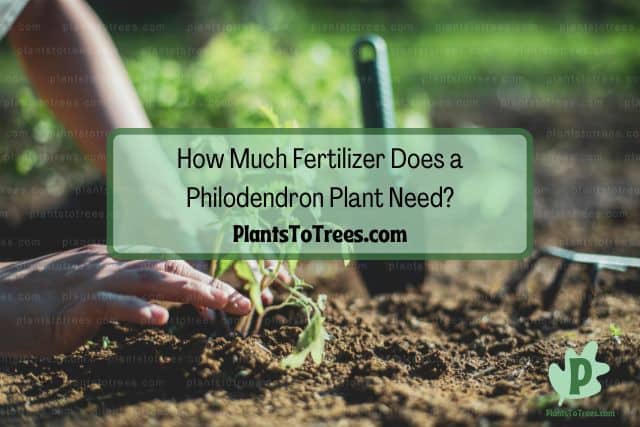
Like other plants, the Philodendron will benefit from fertilizer, but you must apply the right kind and the right amount.
Philodendron plants need a balanced liquid fertilizer, such as 20-20-20, applied once a month during its active growing season. Cut the fertilizing back to once every 6 to 8 weeks in the fall and winter. For the best results, look for a fertilizer that is designed for foliage houseplants.
Make sure you are following the application instructions found on the fertilizer bottle. And never apply more fertilizer than what is instructed on the packaging. It is extremely easy to over feed a Philodendron plant, and while this may not seem too serious, giving the plant too much fertilizer can actually kill it.
Philodendron Plant Diseases To Be Aware Of
While maintaining a strong and healthy plant is the best way to prevent diseases, your Philodendron plant may still develop a problem. Knowing what diseases to look out for, as well as what causes them, is the first line of defense in keeping your Philodendron safe.
Philodendron plants are not susceptible to many diseases, but the few that can attack them are serious. The most common diseases are bacterial leaf spot, bacterial blight, tip curl, and root rot. Knowing what to look for can help you stop these diseases in their tracts.
Bacterial leaf spot causes spots to appear on the leaves. These spots start off as translucent and then darken overtime. Remove and dispose of any leaves that you find with the disease, and avoid watering the plant overhead. Instead, water the Philodendron near the base of the plant.
Bacterial blight also causes spots to form on the infected plant’s foliage, but these spots are small and dark green. Plants with bacterial blight will also have an unpleasant rotting smell to it. Prevention is the best defense against this diseases, so try to refrain from getting the foliage of the Philodendron plant wet.
Tip curl occurs when the Philodendron is over fertilized and will result in the tips of the foliage to curl downward. If the over fertilization continues, the margins of the leaves will begin to brown and the plant’s roots will die.
Root rot is one of the most serious diseases that can affect Philodendron plants. Symptoms start at the plant’s lower leaves and will move up the plant. Water-soaked lesions can start to form on the leaves and stems, and the overall health and appearance of the plant will begin to decline. Root rot is often fatal, but completely preventable. Simply avoid overwatering the plant to keep root rot at bay.
Are There Different Types Of Philodendron Plants?
When you go shopping for houseplants, most big box retail stores and large garden centers simply list a plant with their common name, and don’t divulge into the variety it is. This can lead to some confusion, especially if your newly purchased Philodendron doesn’t look like the ones you saw online.
There are several different types of Philodendron plants available, but the most common one is the heartleaf Philodendron. It features heart-shaped leaves and can grow up to 6 feet indoors. The red leaf Philodendron is another popular variety and has large foliage with various colored variegation.
Another popular choice is the elephant ear Philodendron, which produces bluish gray leaves that change to grayish green as the plant ages. If you’re looking for something with brighter foliage, look no further than the moonlight Philodendron. This plant has fluorescent green foliage, which makes a wonderful addition to indoor gardens. Unlike most other Philodendron varieties, the moonlight type isn’t a vining variety, so it can grow fine in a small pot.
How To Propagate Philodendron Plant
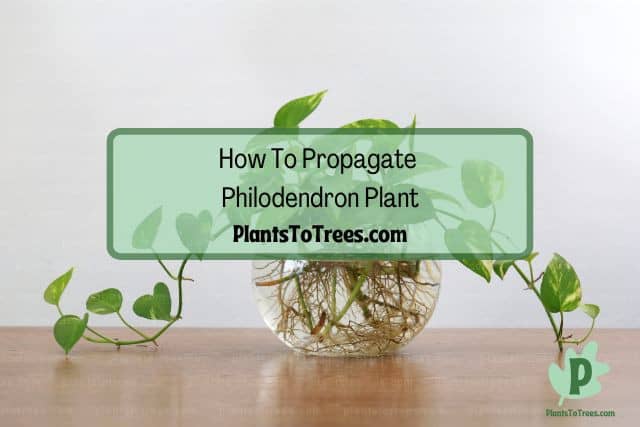
Most houseplants can be easily propagated, which increases the amount of plants you are growing. Some people want to propagate their plants to give as gifts or to trade with other indoor gardeners. No matter what your reasoning, you can easily propagate the Philodendron plant.
Propagated Philodendron plants by taking a stem cutting and then either rooting the plant in soil or water. Some indoor gardeners propagate their Philodendrons when they are pruning the plant. This allows you to reuse the pruned stems instead of merely discarding them.
Before you cut off any old stem, make sure it is a healthy one that has a few leaves and at least one node. If you are rooting in water, remove the lower leaves and then submerge the cut end of the stem in a container filled with water. Make sure that the nodes are completely submerged in the water. Set the container in indirect light and change the water every 3 to 4 days. Roots will start to appear in about 2 to 3 weeks.
If, however, you are rotting in soil, plant the cut end of the cutting in a pot filled with soil that has good drainage. Water well and then set in a location where the plant will receive indirect sunlight. Care for the plant in the same manner as the parent plant.
Consider dipping the cut end of the cutting in rooting hormone to help speed up the process. This isn’t a requirement but it can help roots develop faster.
Is a Philodendron Plant Toxic To Humans?
Sometimes, even the most beloved houseplants can pose a serious risk to our health. Thankfully, most toxic houseplants are only a problem if they are ingested, and most adult humans do not plan on eating houseplants anytime soon. But what about Philodendrons? Are they toxic to humans?
Even though they are one of the most popular houseplants, Philodendrons are poisonous to humans. When consumed, the Philodendron plant will cause a burning sensation and swelling of the lips, mouth, tongue, and throat. Vomiting and diarrhea may also occur.
Unless you have consumed an abundance of the plant, most symptoms will pass within a day and won’t cause any lasting effects. In fact, you probably won’t even need medical treatment. If, however, you are still experiencing symptoms after 48 hours, or have difficulty breathing, seek immediate medical attention.
Is a Philodendron Plant Toxic To Dogs?
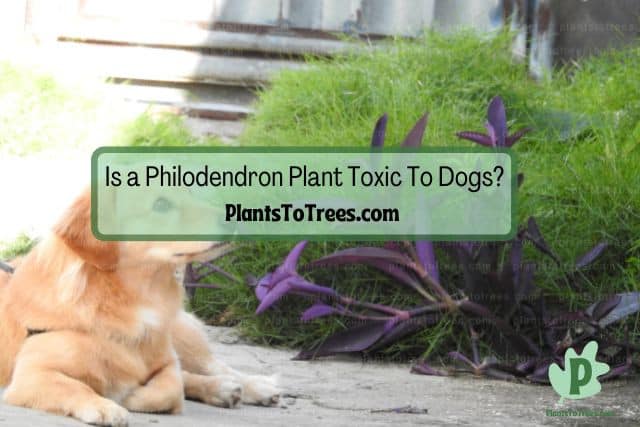
Your dog is your best friend, so it is only natural to want to protect them at all costs. While most dog owners know the dangers of household cleaning products and even foods we as humans consume regularly, some are unaware of the potential harmful side effects that some houseplants can cause.
We at Plants To Trees first published this article on October 26, 2022. Copyright protected.
Philodendron plants are considered toxic to dogs, and are even listed as mild to moderate in their toxicity level. If a dog consumes any portion of the plant, they can experience oral irritation, as well as swelling and pain on their lips and tongue and in their mouth.
Other symptoms include excessive drooling, vomiting, and breathing problems. While it can be frightening for both you and your dog to see them experience Philodendron poisoning, in most cases your dog will be just fine and symptoms typically pass in 24 hours.
If, however, your dog has consumed a large amount of the plant or is having difficulty breathing, immediately contact their veterinarian or call poison control.
Is a Philodendron Plant Toxic To Cats?
While they may seem safe, a lot of houseplants pose a serious risk to the health of your cat. In fact, some houseplants are so toxic that if your cat consumes just a little of them, it can lead to damage to their internal organs. That is why it is important to research whether or not the plant is safe before bringing it indoors with your kitties.
Philodendrons are toxic to cats, and you should never allow your pet to chew or nibble on any portion of this plant. If they do, they can experience pain and irritation in their mouth, as well as on their tongue, lips, and throat.
The article owner is Plants To Trees dot Com and this article was first published on October 26, 2022.
They may also drool excessively and have diarrhea and difficulty breathing and swallowing. While most cases are not fatal, your cat could experience life-threatening symptoms if it consumes a large amount of the plant. Because of this, it is best to seek emergency medical treatment if your cat has ingested a Philodendron plant.
Related Articles
Chinese Evergreen Plant Care Guide
PlantsToTrees.com is the owner of this article and we first published this on October 26, 2022.
